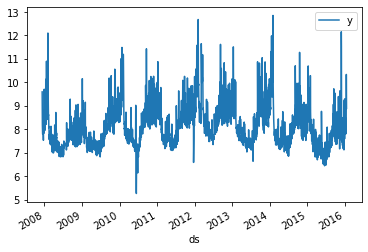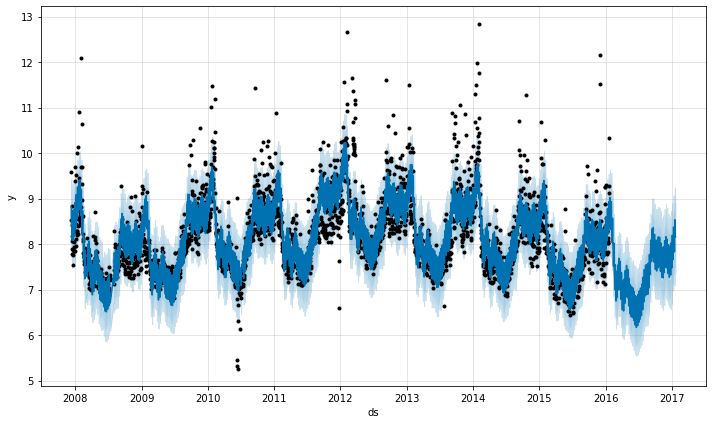时间序列预测
目录
时间序列预测¶
此示例展示了如何使用 Prophet 和 Dask 进行可扩展的时间序列预测。
Prophet 是一种基于加性模型的时间序列数据预测方法,其中使用年度、每周和每日季节性以及假日效应来拟合非线性趋势。
正如在规模化预测中所讨论的,大型数据集并不是团队遇到的唯一类型的扩展挑战。在本例中,我们将重点关注该论文中指出的第三种扩展挑战:
在大多数实际环境中,会创建大量预测,这就需要高效、自动化的方法来评估和比较它们,以及检测何时它们可能表现不佳。当进行数百甚至数千次预测时,让机器完成模型评估和比较的繁重工作,同时有效利用人工反馈来解决性能问题变得非常重要。
这听起来是 Dask 的绝佳机会。我们将结合使用 Prophet 和 Dask 来并行化研究的诊断阶段。它并不试图并行化模型本身的训练。
[1]:
import pandas as pd
from prophet import Prophet
Importing plotly failed. Interactive plots will not work.
我们将逐步介绍 Prophet 快速入门中的示例。这些值代表了 Peyton Manning 维基百科页面的对数每日页面浏览量。
[2]:
df = pd.read_csv(
'https://raw.githubusercontent.com/facebook/prophet/master/examples/example_wp_log_peyton_manning.csv',
parse_dates=['ds']
)
df.head()
[2]:
| ds | y | |
|---|---|---|
| 0 | 2007-12-10 | 9.590761 |
| 1 | 2007-12-11 | 8.519590 |
| 2 | 2007-12-12 | 8.183677 |
| 3 | 2007-12-13 | 8.072467 |
| 4 | 2007-12-14 | 7.893572 |
[3]:
df.plot(x='ds', y='y');

拟合模型需要几秒钟。Dask 在这里完全没有参与。
[4]:
%%time
m = Prophet(daily_seasonality=False)
m.fit(df)
/usr/share/miniconda3/envs/dask-examples/lib/python3.9/site-packages/prophet/forecaster.py:896: FutureWarning: The frame.append method is deprecated and will be removed from pandas in a future version. Use pandas.concat instead.
components = components.append(new_comp)
CPU times: user 2.46 s, sys: 108 ms, total: 2.56 s
Wall time: 2.61 s
[4]:
<prophet.forecaster.Prophet at 0x7f73c3efc9d0>
我们可以进行预测。同样,Dask 在这里也没有参与。
[5]:
future = m.make_future_dataframe(periods=365)
forecast = m.predict(future)
m.plot(forecast);
/usr/share/miniconda3/envs/dask-examples/lib/python3.9/site-packages/prophet/forecaster.py:896: FutureWarning: The frame.append method is deprecated and will be removed from pandas in a future version. Use pandas.concat instead.
components = components.append(new_comp)
/usr/share/miniconda3/envs/dask-examples/lib/python3.9/site-packages/prophet/forecaster.py:896: FutureWarning: The frame.append method is deprecated and will be removed from pandas in a future version. Use pandas.concat instead.
components = components.append(new_comp)

并行诊断¶
Prophet 包含一个 prophet.diagnostics.cross_validation 函数方法,该方法使用模拟历史预测来提供模型质量的一些概念。
这是通过在历史记录中选择截止点来完成的,并且对于每个截止点,仅使用截至该截止点的数据来拟合模型。然后我们可以将预测值与实际值进行比较。
更多信息请参阅 https://fbdocs.cn/prophet/docs/diagnostics.html。
在内部,cross_validation 生成一个要尝试的截止值列表。Prophet 为每个截止值拟合一个模型并计算一些指标。默认情况下,每个模型是按顺序拟合的,但可以使用 parallel= 关键字并行训练模型。在单机上,parallel="processes" 是个不错的选择。对于希望在集群上分布工作的大型问题,在创建 Client 连接到集群后,请使用 parallel="dask"。
[6]:
import dask
from distributed import Client, performance_report
import prophet.diagnostics
client = Client(threads_per_worker=1)
client
[6]:
Client
Client-97840748-0de0-11ed-9f87-000d3a8f7959
| 连接方法: Cluster 对象 | 集群类型: distributed.LocalCluster |
| 仪表板: http://127.0.0.1:8787/status |
集群信息
LocalCluster
c05d4eee
| 仪表板: http://127.0.0.1:8787/status | 工作器 2 |
| 总线程数 2 | 总内存: 6.78 GiB |
| 状态: 运行中 | 使用进程: True |
调度器信息
调度器
Scheduler-e9054925-07ca-4262-a860-0ebc0723bd70
| 通信: tcp://127.0.0.1:44751 | 工作器 2 |
| 仪表板: http://127.0.0.1:8787/status | 总线程数 2 |
| 启动时间: 刚刚 | 总内存: 6.78 GiB |
工作器
工作器:0
| 通信: tcp://127.0.0.1:34575 | 总线程数 1 |
| 仪表板: http://127.0.0.1:39267/status | 内存: 3.39 GiB |
| Nanny: tcp://127.0.0.1:39955 | |
| 本地目录: /home/runner/work/dask-examples/dask-examples/applications/dask-worker-space/worker-toj_a9te | |
工作器:1
| 通信: tcp://127.0.0.1:35829 | 总线程数 1 |
| 仪表板: http://127.0.0.1:34391/status | 内存: 3.39 GiB |
| Nanny: tcp://127.0.0.1:43645 | |
| 本地目录: /home/runner/work/dask-examples/dask-examples/applications/dask-worker-space/worker-1yf153x7 | |
[7]:
%%time
df_cv = prophet.diagnostics.cross_validation(
m, initial="730 days", period="180 days", horizon="365 days",
parallel="dask"
)
INFO:prophet:Making 11 forecasts with cutoffs between 2010-02-15 00:00:00 and 2015-01-20 00:00:00
INFO:prophet:Applying in parallel with <Client: 'tcp://127.0.0.1:44751' processes=2 threads=2, memory=6.78 GiB>
CPU times: user 868 ms, sys: 122 ms, total: 990 ms
Wall time: 27.5 s
运行时务必查看 Dask 仪表板。模型在集群上并行拟合。开始时,将模型和数据移动到工作器会产生一些开销,但之后扩展效果看起来非常好。
